Enzyme Mechanism Corrects Cellular DNA Damage
By LabMedica International staff writers
Posted on 16 Oct 2017
Researchers have identified a mechanism used by cells to correct damage to their DNA caused by chemotherapeutic drugs and some antibiotics.Posted on 16 Oct 2017
The enzyme topoisomerase 2 (TOP2) creates DNA double-strand breaks in order to regulate DNA topology and is critical for processes such as replication and transcription. A covalent complex between TOP2 and DNA (TOP2cc), which impedes the activity of the topoisomerase, is an intermediate in the reaction that can be trapped by drugs.

Image: An illustration of a TOP2 DNA-protein cross-link (TOP2cc in magenta) bound to DNA (Photo courtesy of Dr. Scott Williams).
In a recent study, investigators at the [U.S.] National Institutes of Health/National Institute of Environmental Health Sciences (Bethesda, MD, USA) reported in the September 29, 2017, online edition of the journal Science that the SUMO ligase enzyme ZATT promoted the resolution of TOP2cc by means of another enzyme, tyrosyl-DNA phosphoesterase 2 (TDP2), both by enhancing recruitment of TDP2 to SUMOylated TOP2 and by enhancing the hydrolase activity of TDP2.
SUMO (Small Ubiquitin-like Modifier) proteins are a family of small proteins that are covalently attached to and detached from other proteins in cells to modify their function. SUMOylation is a post-translational modification involved in various cellular processes, such as nuclear-cytosolic transport, transcriptional regulation, apoptosis, protein stability, response to stress, and progression through the cell cycle. SUMO proteins are similar to ubiquitin, and SUMOylation is directed by an enzymatic cascade analogous to that involved in ubiquitination. In contrast to ubiquitin, SUMO is not used to tag proteins for degradation.
"In this study, we discovered a new molecular disarmament apparatus for these cell-killing bombs (TOP2cc)," said senior author Dr. Scott Williams, deputy chief of the genome integrity and structural biology laboratory at the National Institute of Environmental Health Sciences. "ZATT is like a bomb sniffing dog, so when it locates its target, it sounds an alarm to mobilize the recruitment of TDP2, which cuts the red wire to disarm these threats."
Related Links:
[U.S.] National Institutes of Health/National Institute of Environmental Health Sciences













